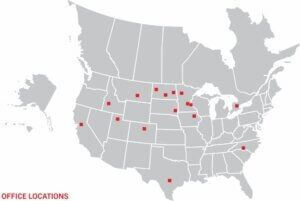Recent Texas Safety Regulation Serves as a Wake-up Call for Utilities Around the Country

March 15, 2021
A recent safety regulation raises the bar for Texas power utilities that own and operate transmission assets – and it serves as a wake-up call for power utilities across the country.
The passage of the William Thomas Heath Powerline Safety Act (HB 4150), which was signed into law by Texas Gov. Greg Abbott on June 14 of 2019, requires utilities throughout Texas to submit additional safety reports on their transmission infrastructure. The regulation was introduced in response to a 2017 accident that claimed the lives of three Texas Boy Scouts when the mast of their sailboat struck a low hanging transmission line crossing a section of a lake. It was reported that the power line over the lake was 13 feet lower than allowable limits set by the National Electric Safety Code (NESC).
In February 2020, the Public Utility Commission of Texas officially adopted the William Thomas Heath Power Line Safety Act into the Texas Administrative Code, named in honor of the three Boy Scouts killed in the tragedy. The new regulation requires utilities that own transmission or distribution infrastructure to comply with several requirements, which include:
- Requiring electric utilities to report the type of hazard and safety training they provide to their employees annually.
- Requiring electric utilities to report public injuries and fatalities involving any of their noncompliance power lines.
- Every five years, requiring electric utilities to publicly report the percentage of transmission lines they inspected in the past five years as well as the percentage they plan to inspect in the coming five years to ensure proper clearances.
While this new safety regulation sets a new standard for Texas utilities, it also puts other power utilities across the country on notice of what they may see in the future.
Preventing the Next Tragedy
Several of our clients have asked us for our insight on this new regulation and what they should do next.
Regardless of this new regulation, we strongly believe that all electric utilities should carefully and thoroughly study their transmission and distribution systems following a set schedule to ensure that tragedies involving human loss never happen. The human life that was lost is reason enough to act now, but the financial costs of litigation combined with the reputational costs to your organization, should provide ample incentive to act decisively.
As a first step, Ulteig recommends that utilities consider budgeting for regular LiDAR surveys (Light Detection and Ranging/pulsed-laser surveys), allowing utilities to collect high-resolution and high-accuracy data on each segment of their transmission lines. The Ulteig team can utilize this survey data to accurately model the transmission lines using PLS-CADD software. With this model, we can determine if the lines meet the NESC and other code requirements.
After the modeling is complete in PLS-CADD, the next step is to report any code violations and make recommendations on changes or modifications required to bring any deficient lines up to code.
Besides meeting the legislative requirements outlined in the new Texas regulation, there are other benefits to going through this process, including:
- Higher quality data and a more informed budgeting process – transmission modeling is comparable to performing a home inspection every five years to get ahead of potential problems. It is performed in a similar cycle over a five-year period, (e.g., inspect the basement one year then the main level the next year, etc.). After the completion of one full cycle, the data will never be more than five years old. This provides utilities with a recent and reliable dataset and provides an opportunity for utilities to more wisely budget for future improvements.
- Prevention – a LiDAR survey followed by transmission modeling allows a utility to get ahead of potential problems. Checking for violations or defects now allows a utility to get current data models into its system which ultimately helps plan for future projects.
- Emergency situations – a LiDAR survey accompanied with a transmission line model allows for easier and faster fixes to transmission lines in the event of any emergency (storm damage, downed structures, etc.). If the model is already in your database, it can be quickly referenced and the team can be confident that the data is accurate and current. Pole classes, conductor, tensions, insulator types, etc. can all be easily referenced to facilitate the repairs that need to be made in the field.
- Preparedness for quick decision making – when an entity wants to interconnect renewable energy to your grid, you can utilize these transmission models to support faster decisions and smoother interconnection agreements. In some instances, additional electrical studies will need to be performed. Ulteig also has a dedicated group to facilitate these systems planning and electrical study services.
For utilities located outside of Texas, where complying with the mandate of the William Thomas Heath Power Line Safety Act isn’t required, we understand that the additional cost of voluntarily complying with the standards set by the new regulation may deter some utilities from acting. However, we see this as an investment for long-term safety and success.
Ready to Act When You Are
At Ulteig, our experienced Transmission team has designed or remediated more than 2,800 miles of transmission lines in the last five years alone. Our team is dedicated to asking the difficult questions necessary to obtain the highest quality solution – and in turn, help client utilities avoid problems in the immediate and long-term future.
To learn more about Ulteig’s expertise in transmission line design and modeling, as well as its expertise to reduce the risks surrounding your power utility, contact us today.
By Tyler Streich, P.E., Transmission Technical Manager

Tyler is a Technical Manager with 18 years of engineering experience designing single- and double-circuit lines from 34.5kV to 500kV. This includes all aspects of line design from conceptual routing studies, to detailed engineering, to material selection and procurement, to construction walkthroughs and inspection. His recent roles include managing teams of engineers focused on transmission line design.
And Matt Beach, P.E., Transmission Engineer

Matt is an Engineer in the Transmission and Distribution Department with nine years of experience. . His engineering and design expertise includes transmission line design and engineering; distribution underbuild design; structure point load calculations; development of structure drawings for steel, concrete, and laminated wood pole procurement; pole vendor calc and drawing reviews; materials specification; developing and updating owners engineering standards and specifications; and preparing and reviewing construction drawings, packages, and contracts. Matt’s project experience encompasses new greenfield design and brownfield additions and upgrades, including voltages of 34.5kV up to 345kV.
WHAT MAKES ULTEIG DIFFERENT?
From global energy producers to locally funded cities and private developers to government agencies, the clients we serve encompass a broad range of relationships and projects. Find out why Ulteig is a leader in the engineering industry.
Contact Us
